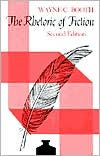5
1


Paperback(REV)
$31.00
-
PICK UP IN STORECheck Availability at Nearby Stores
Available within 2 business hours
Related collections and offers
31.0
In Stock
Overview
The first edition of The Rhetoric of Fiction transformed the criticism of fiction and soon became a classic in the field. One of the most widely used texts in fiction courses, it is a standard reference point in advanced discussions of how fictional form works, how authors make novels accessible, and how readers recreate texts, and its concepts and terms—such as "the implied author," "the postulated reader," and "the unreliable narrator"—have become part of the standard critical lexicon.
For this new edition, Wayne C. Booth has written an extensive Afterword in which he clarifies misunderstandings, corrects what he now views as errors, and sets forth his own recent thinking about the rhetoric of fiction. The other new feature is a Supplementary Bibliography, prepared by James Phelan in consultation with the author, which lists the important critical works of the past twenty years—two decades that Booth describes as "the richest in the history of the subject."
For this new edition, Wayne C. Booth has written an extensive Afterword in which he clarifies misunderstandings, corrects what he now views as errors, and sets forth his own recent thinking about the rhetoric of fiction. The other new feature is a Supplementary Bibliography, prepared by James Phelan in consultation with the author, which lists the important critical works of the past twenty years—two decades that Booth describes as "the richest in the history of the subject."

Product Details
| ISBN-13: | 9780226065588 |
|---|---|
| Publisher: | University of Chicago Press |
| Publication date: | 02/15/1983 |
| Edition description: | REV |
| Pages: | 572 |
| Sales rank: | 451,755 |
| Product dimensions: | 5.30(w) x 7.90(h) x 1.10(d) |
About the Author
Wayne C. Booth (1921–2005) was the George M. Pullman Distinguished Service Professor Emeritus in English Language and Literature at the University of Chicago. His many books include The Rhetoric of Fiction and For the Love of It: Amateuring and Its Rivals, both published by the University of Chicago Press.
Table of Contents
Foreword to the Second EditionPreface to the First Edition
Acknowledgments
Part I: Artistic Purity and the Rhetoric of Fiction
I. Telling and Showing
Authoritative "Telling" in Early Narration
Two Stories from the Decameron
The Author's Many Voices
II. General Rules, I: "True Novels Must Be Realistic"
From Justified Revolt to Crippling Dogma
From Differentiated Kinds to Universal Qualities
General Criteria in Earlier Periods
Three Sources of General Criteria: The Work, the Author, the Reader
Intensity of Realistic Fiction
The Novel as Unmediated Reality
On Discriminating among Realisms
The Ordering of Intensities
III. General Rules, II: "All Authors Should be Objective"
Neutrality and the Author's "Second Self"
Impartiality and "Unfair" Emphasis
Impassibilité
Subjectivism Encouraged by Impersonal Techniques
IV. General Rules III: "True Art Ignores the Audience"
"True Artists Write Only for Themselves
Theories of Pure Art
The "Impurity" of Great Literature
Is a Pure Fiction Theoretically Desirable?
V. General Rules, IV: Emotions, Beliefs, and the Reader's Objectivity
"Tears and Laughter Are, Aesthetically, Frauds"
Types of Literary Interest (and Distance)
Combinations and Conflicts of Interests
The Role of Belief
Belief Illustrated: The Old Wives' Tale
VI. Types of Narration
Person
Dramatized and Undramatized Narrators
Observers and Narrator-Agents
Scene and Summary
Commentary
Self-Conscious Narrators
Variations of Distance
Variations in Support or Correction
Privilege
Inside Views
Part II: The Author's Voice in Fiction
VII. The Uses of Reliable Commentary
Providing the Facts, Picture, or Summary
Molding Beliefs
Relating Particulars to the Established Norms
Heightening the Significance of Events
Generalizing the Significance of Events
Generalizing the Significance of the Whole Work
Manipulating Mood
Commenting Directly on the Work Itself
VIII. Telling as Showing: Dramatized Narrators, Reliable and Unreliable
Reliable Narrators as Dramatized Spokesmen for the Implied Author
"Fielding" in Tom Jones
Imitators of Fielding
Tristram Shandy and the Problem of Formal Coherence
Three Formal Traditions: Comic Novel, Collection, and Satire
The Unity of Tristram Shandy
Shandean Commentary, Good and Bad
IX. Control of Distance in Jane Austen's Emma
Sympathy and Judgment in Emma
Sympathy through Control of Inside Views
Control of Judgment
The Reliable Narrator and the Norms of Emma
Explicit Judgments on Emma Woodhouse
The Implied Author as Friend and Guide
Part III: Impersonal Narration
X. The Uses of Authorial Silence
"Exit Author" Once Again
Control of Sympathy
Control of Clarity and Confusion
"Secret Communion" between Author and Reader
XI. The Price of Impersonal Narration, I: Confusion of Distance
The Turn of the Screw as Puzzle
Troubles with Irony in Earlier Literature
The Problem of Distance in A Portrait of the Artist
XII. The Price of Impersonal Narration, II: Henry James and the Unreliable Narrator
The Development from Flawed Reflector into Subject
The Two Liars in "The Liar"
"The Purloining of the Aspern Papers" or "The Evocation of Venice"?
"Deep Readers of the World, Beware!"
XIII. The Morality of Impersonal Narration
Morality and Technique
The Seductive Point of View: Céliné as Example
The Author's Moral Judgment Obscured
The Morality of Elitism
Afterword to the Second Edition: The Rhetoric in Fiction and Fiction as Rhetoric: Twenty-One Years Later
Bibliography
Supplementary Bibliography, 1961-82, by James Phelan
Index to the First Edition
Index to the Bibliographies
From the B&N Reads Blog
Page 1 of
